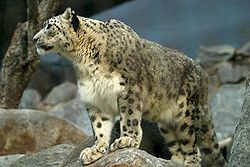
Khunjerab National Park
Encyclopedia
| Khunjerab National Park | |
| Land: | 560,714 acres |
| Region: | Gilgit-Baltistan |
| Founded: | 1975 |

National park
A national park is a reserve of natural, semi-natural, or developed land that a sovereign state declares or owns. Although individual nations designate their own national parks differently A national park is a reserve of natural, semi-natural, or developed land that a sovereign state declares or...
in Gilgit Baltistan of Pakistan
Pakistan
Pakistan , officially the Islamic Republic of Pakistan is a sovereign state in South Asia. It has a coastline along the Arabian Sea and the Gulf of Oman in the south and is bordered by Afghanistan and Iran in the west, India in the east and China in the far northeast. In the north, Tajikistan...
. It is one of the highest altitude parks in the world. It provides the habitat for a number of endangered and threatened animal species
Species
In biology, a species is one of the basic units of biological classification and a taxonomic rank. A species is often defined as a group of organisms capable of interbreeding and producing fertile offspring. While in many cases this definition is adequate, more precise or differing measures are...
like the Snow leopard
Snow Leopard
The snow leopard is a moderately large cat native to the mountain ranges of South Asia and Central Asia...
, Marco Polo sheep
Marco Polo sheep
The Marco Polo sheep is a subspecies of argali sheep, named after Marco Polo. Their habitat is the mountainous regions of Central Asia. Marco Polo sheep are distinguishable mostly by their large size and spiraling horns. Their conservation status is "near threatened" and efforts have been made to...
, and Himalayan
Himalayas
The Himalaya Range or Himalaya Mountains Sanskrit: Devanagari: हिमालय, literally "abode of snow"), usually called the Himalayas or Himalaya for short, is a mountain range in Asia, separating the Indian subcontinent from the Tibetan Plateau...
Ibex.
The park lies within the Karakoram-West Tibetan Plateau alpine steppe
Karakoram-West Tibetan Plateau alpine steppe
The Karakoram-West Tibetan Plateau alpine steppe is a montane grasslands and shrublands ecoregion found in parts of Pakistan, China, Afghanistan, and India.-Setting:...
ecoregion
Ecoregion
An ecoregion , sometimes called a bioregion, is an ecologically and geographically defined area that is smaller than an ecozone and larger than an ecosystem. Ecoregions cover relatively large areas of land or water, and contain characteristic, geographically distinct assemblages of natural...
and is one of the most important alpine biodiversity
Biodiversity
Biodiversity is the degree of variation of life forms within a given ecosystem, biome, or an entire planet. Biodiversity is a measure of the health of ecosystems. Biodiversity is in part a function of climate. In terrestrial habitats, tropical regions are typically rich whereas polar regions...
regions within Pakistan. The WWF
World Wide Fund for Nature
The World Wide Fund for Nature is an international non-governmental organization working on issues regarding the conservation, research and restoration of the environment, formerly named the World Wildlife Fund, which remains its official name in Canada and the United States...
of Pakistan has a management plan to protect the alpine flora
Alpine tundra
Alpine tundra is a natural region that does not contain trees because it is at high altitude. Alpine tundra is distinguished from arctic tundra, because alpine soils are generally better drained than arctic soils...
in Khunjerab National Park will on focus on community-based conservation
Community-based conservation
Community-based conservation is a res conservation movements that emerged in the 1980s through escalating protests and subsequent dialogue with local communities affected by international attempts to protect the biodiversity of the earth. Older conservation movements disregarded the interests of...
with a strong element of environmental awareness raising. The aim is to control grazing, and increase the population of Snow leopards, Marco Polo and Blue Sheep.

